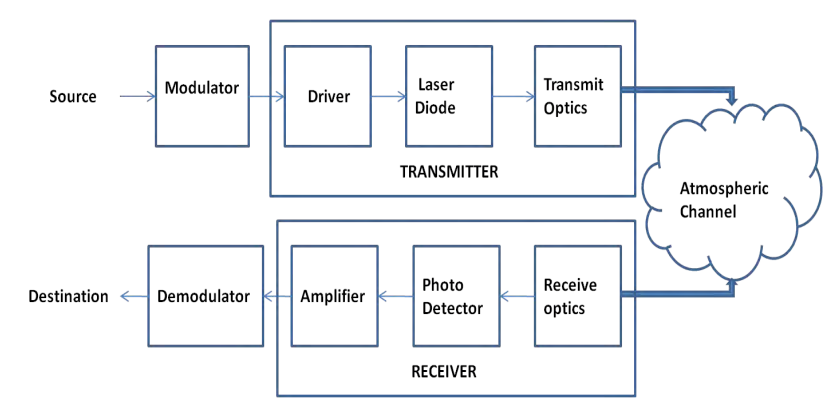Enhance Data and Power Transmission in Free-Space Optical Systems Under Environmental Circumstances
Keywords:
FSO, LOS, QAM, RF, OFDMAbstract
Free space optics is one of the new technologies that is now being utilized to replace radio frequency wireless communication because of its benefits, including cost, speed, bandwidth, few mistakes, and effective communication. The FSO offers far higher-quality services than the RF communication network. Free space optics is an unlicensed band, which makes it less expensive than technology that is licensed. Communication is affected by atmospheric conditions since the atmospheric channel is employed for transmission. This study tries to maintain communication and send data under normal and turbulent conditions
Downloads
References
Khalighi MA & Uysal M (2014), Survey on Free Space Optical Communication: A Communication Theory Perspective, IEEE Communications Surveys and Tutorials, pp.2231-2258.
Bloom S, Korevaar E, Schuster J, & Willebrand H (2003), Under-standing the performance of free-space optics, Journal of Optical Networks, Vol. 2, no. 6, pp. 178–200, Jun. 2003.
Holzmann GJ & Pehrson B, The Early History of Data Networks (Perspectives). Hoboken, NJ, USA: Wiley, (1994).
Huurdeman AA, The Worldwide History of Telecommunications, Hoboken, NJ, USA: Wiley-Interscience, (2003).
Lee S, Kwon JK, Jung SY, & Kwon YH (2012), Evaluation of visible
Light communication channel delay profiles for automotive applications, Eurasip Journal Wireless Communication Network, Vol.12, no. 1, pp. 370-378.
Chan VWS (2003), Optical satellite networks, Journal of Light and. Technology, Vol. 21, no. 11, pp. 2811–2827.
Kaushal H et al. (2017), Free Space Optical Communication, Optical Networks, Springer.
Andrews LC, Phillips RL, Hopen CY, & Al-Habash MA (1999), Theory of optical scintillation, Journal of Optical Society, Vol. 16, no. 6, pp. 1417–1429.
Wayne DT (2010), The PDF of irradiance for a free space optics communication Channel: A physics based model at the University of Central Florida
Kaur G, Singh H, Sappal AS (2017), Free Space Optical Using Different Modulation Techniques’ Review, International Journal of Engineering Trends and Technology, Vol. 43, no.2, pp.412-410.
G. D. Verma, A. Mathur, Y. Ai, and M. J. I. C. L. Cheffena, "Mixed dual-hop IRS-assisted FSO-RF communication system with H-ARQ protocols," vol. 26, no. 2, pp. 384-388, 2021.
O. B. Yahia, E. Erdogan, G. K. Kurt, I. Altunbas and H. Yanikomeroglu, "A Weather-Dependent Hybrid RF/FSO Satellite Communication for Improved Power Efficiency," in IEEE Wireless Communications Letters, vol. 11, no. 3, pp. 573-577, March 2022, doi: 10.1109/LWC.2021.3136444.
S. C. Tokgoz, S. Althunibat, S. L. Miller and K. A. Qaraqe, "On the Secrecy Capacity of Hybrid FSO-mmWave Wiretap Channels," in IEEE Transactions on Vehicular Technology, vol. 71, no. 4, pp. 4073-4086, April 2022, doi: 10.1109/TVT.2022.3148238.
G. D. Verma, A. Mathur, Y. Ai and M. Cheffena, "Mixed Dual-Hop IRS-Assisted FSO-RF Communication System with H-ARQ Protocols," in IEEE Communications Letters, vol. 26, no. 2, pp. 384-388, Feb. 2022, doi: 10.1109/LCOMM.2021.3129594.
M. Singh, S. N. Pottoo, J. Malhotra, A. Grover, and M. H. Aly, “Millimeter-wave hybrid OFDM-MDM radio over free space optical transceiver for 5G services in desert environment.” Alexandria Engineering Journal, vol. 60, no. 5, pp. 4275-4285, 2021, doi: 10.1016/j.aej.2021.03.029.
M. Garlinska, A. Pregowska, I. Gutowska, M. Osial, and J. Szczepanski, “Experimental Study of the Free Space Optics Communication System Operating in the 8–12 μm Spectral Range.” Electronics, vol. 10, no. 8, p. 875, 2021, doi: 10.3390/electronics10080875.
M. Abdullatif, M. Haji Ali, and R. Khal, “Proposed Method For Improving The Performance Of Wireless Optical Link FSO Using The Center Of Balance With a Laser Fog Sensor.” Association of Arab Universities Journal of Engineering Sciences, vol. 27, no. 4, pp. 72-78, 2020, doi: 10.33261/https://doi.org/10.33261/jaaru.2020.27.4.007.
M. A. Esmail, A. M. Ragheb, H. A. Fathallah, M. Altamimi, and S. A. Alshebeili, “5G-28 GHz Signal Transmission Over Hybrid All-Optical FSO/RF Link in Dusty Weather Conditions.” IEEE Access, vol. 7, pp. 24404-24410, 2019, doi: 10.1109/access.2019.2900000.
G. Alnwaimi, H. Boujemaa, and K. Arshad, “Optimal Packet Length for Free-Space Optical Communications with Average SNR Feedback Channel.” Journal of Computer Networks and Communications, vol. 2019, pp. 1-8, 2019, doi: 10.1155/2019/4703284.
M. Z. Chowdhury, M. T. Hossan, A. Islam, and Y. M. Jang, “A Comparative Survey of Optical Wireless Technologies: Architectures and Applications.” IEEE Access, vol. 6, pp. 9819-9840, 2018, doi: 10.1109/access.2018.2792419.

Downloads
Published
How to Cite
Issue
Section
License

This work is licensed under a Creative Commons Attribution-ShareAlike 4.0 International License.
All papers should be submitted electronically. All submitted manuscripts must be original work that is not under submission at another journal or under consideration for publication in another form, such as a monograph or chapter of a book. Authors of submitted papers are obligated not to submit their paper for publication elsewhere until an editorial decision is rendered on their submission. Further, authors of accepted papers are prohibited from publishing the results in other publications that appear before the paper is published in the Journal unless they receive approval for doing so from the Editor-In-Chief.
IJISAE open access articles are licensed under a Creative Commons Attribution-ShareAlike 4.0 International License. This license lets the audience to give appropriate credit, provide a link to the license, and indicate if changes were made and if they remix, transform, or build upon the material, they must distribute contributions under the same license as the original.





